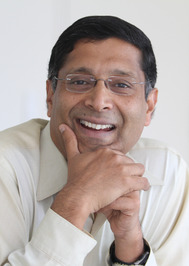Arvind Subramanian
Goodreads Author
Member Since
June 2012

|
Of Counsel
|
|

|
Eclipse: Living in the Shadow of China's Economic Dominance
—
published
2011
—
8 editions
|
|

|
India's Turn: Understanding the Economic Transformation
—
published
2008
—
3 editions
|
|

|
A Sixth Of Humanity: Independent India's Development Odyssey - A Financial Times Book of the Year (2025)
by |
|

|
Trade and Trade Policies in Eastern and Southern Africa (Imf Occasional Paper, 196)
—
published
2000
—
2 editions
|
|

|
Africa's Trade Revisted
—
published
2001
—
2 editions
|
|

|
The Wto Promotes Trade, Strongly But Unevenly
—
published
2003
—
2 editions
|
|

|
Addressing the Natural Resource Curse: An Illustration from Nigeria
—
published
2003
—
2 editions
|
|

|
The Egyptian Stabilization Experience - An Analytical Retrospective
—
published
1997
—
2 editions
|
|

|
Optimal Tariffs - Theory and Practice
—
published
1993
—
2 editions
|
|
“The first and the most exciting thing for me as someone who has studied growth across countries from a macro perspective was that there is something truly unique about the Indian development model. I call this the ‘precocious development model’, since a precocious child does things far ahead of its time—in both the good and bad sense.
Political scientists have often observed that India is a complete outlier in having sustained democracy at very low levels of income, low levels of literacy, with deep social fissures, and with a highly agrarian economy. Almost no country in the world has managed that under these conditions. I think the only continuous democracies have all been small countries (Costa Rica, Barbados, Jamaica, Mauritius and Botswana) with higher levels of literacy and fewer social divisions.
The second part of the precocious model is that it entails not just precocious politics but also precocious economics. There are many ways of explaining this precocious economics model, but I focus on two.
Most countries grow by either specializing in or exploiting their minerals—as in the old model—and in some cases, exploiting their geography. But most of the post-war growth experiences have come about by becoming manufacturing powerhouses, especially starting with low-skill labour and going up the value-added spectrum. Korea, Taiwan and China are classic examples, specializing in textiles and clothing initially and now becoming major exporters of electronics, cars, IT products, etc.”
― Of Counsel
Political scientists have often observed that India is a complete outlier in having sustained democracy at very low levels of income, low levels of literacy, with deep social fissures, and with a highly agrarian economy. Almost no country in the world has managed that under these conditions. I think the only continuous democracies have all been small countries (Costa Rica, Barbados, Jamaica, Mauritius and Botswana) with higher levels of literacy and fewer social divisions.
The second part of the precocious model is that it entails not just precocious politics but also precocious economics. There are many ways of explaining this precocious economics model, but I focus on two.
Most countries grow by either specializing in or exploiting their minerals—as in the old model—and in some cases, exploiting their geography. But most of the post-war growth experiences have come about by becoming manufacturing powerhouses, especially starting with low-skill labour and going up the value-added spectrum. Korea, Taiwan and China are classic examples, specializing in textiles and clothing initially and now becoming major exporters of electronics, cars, IT products, etc.”
― Of Counsel
Comments (showing 1-1)
post a comment »
date newest »
newest »
 newest »
newest »
message 1:
by
Arvind
Jul 11, 2012 11:47AM
 I must have read over 200 books in the last year. I hope to list them gradually with brief comments on each. Recent favorites include the Peter Hessler "trilogy" on China; Frank Fukuyama's "Origins of Political Order,"; Graham Green's "Quiet American" and "Power and the Glory"; Julian Barnes' "Sense of an Ending;" three Richard Kapucynski books; Le Clezio's "The Prospector"; Ian Morris' "Why the West Rules for Now,"; "Chinaman" by Karunatilaka; "Submission" by Amy Waldman; David Mitchell's "Thousand Autumns of Jacob de Zoet"; Siddhartha Mukherjee "Emperor of All Maladies," Kissinger's "On China"; Ezra Vogel's biography of Deng Xiaoping; "Terrible Splendor" the book on the famous Davis cup tennis match between Baron von Cramm and Don Budge; Liqauat Ahamed's "Lords of Finance;" Simon Johnson and James Kwak's "White House Burning," Katherine Boo's book on the slums of Mumbai; and for the n-th time keynes' "Economic Consequences of the Peace."
I must have read over 200 books in the last year. I hope to list them gradually with brief comments on each. Recent favorites include the Peter Hessler "trilogy" on China; Frank Fukuyama's "Origins of Political Order,"; Graham Green's "Quiet American" and "Power and the Glory"; Julian Barnes' "Sense of an Ending;" three Richard Kapucynski books; Le Clezio's "The Prospector"; Ian Morris' "Why the West Rules for Now,"; "Chinaman" by Karunatilaka; "Submission" by Amy Waldman; David Mitchell's "Thousand Autumns of Jacob de Zoet"; Siddhartha Mukherjee "Emperor of All Maladies," Kissinger's "On China"; Ezra Vogel's biography of Deng Xiaoping; "Terrible Splendor" the book on the famous Davis cup tennis match between Baron von Cramm and Don Budge; Liqauat Ahamed's "Lords of Finance;" Simon Johnson and James Kwak's "White House Burning," Katherine Boo's book on the slums of Mumbai; and for the n-th time keynes' "Economic Consequences of the Peace."
reply
|
flag



























